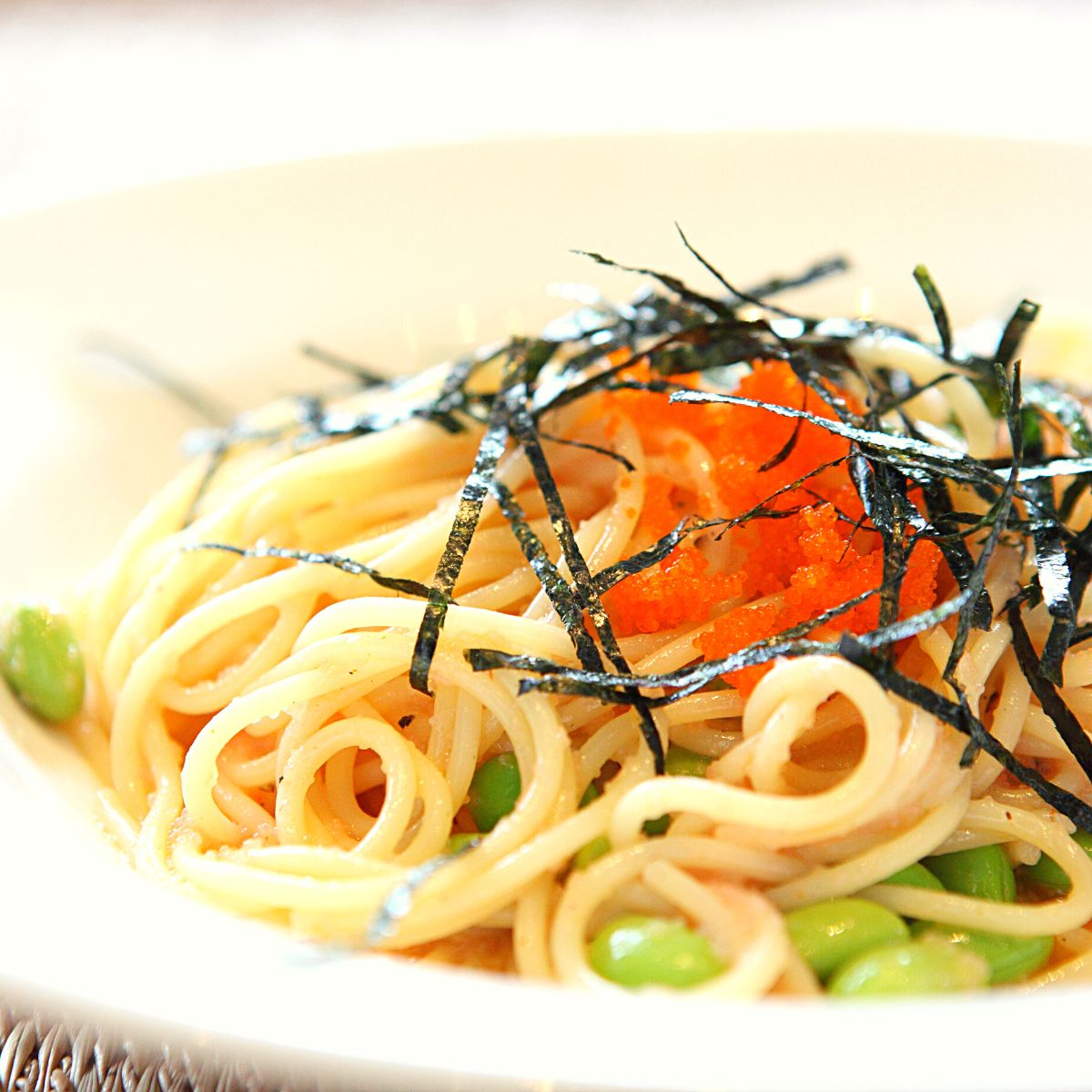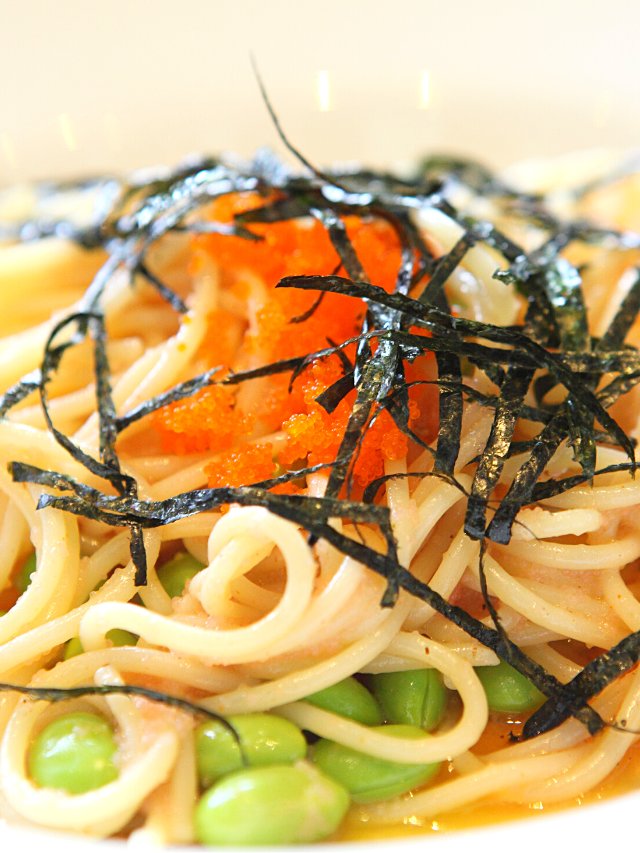This Creamy Mentaiko Pasta recipe is a delectable cod roe pasta made in the signature style of Japanese cuisine that just requires a few simple ingredients. It’s understandable why this new classic has become a staple in Japanese households, given that it boasts a thick, creamy sauce that is bursting with umami.
A Brief History of Japanese Pasta
Noodles had been consumed in Japan (and most of Asia) for a long time, but it wasn’t until 1945, following the conclusion of World War II, that America brought spaghetti to Japan in considerable numbers. American-style spaghetti with meat sauce quickly gained popularity in Japan’s Western-style cafés because of the country’s food deficit and curiosity about American culture.
The creation of Mentaiko Pasta is attributed to a little pasta business in Shibuya named Kabé No Ana (壁の穴), which translates to “hole in the wall.” According to the legend, a violinist from an orchestra on tour in Europe brought back some caviar.
He brought it to the restaurant and asked them to cook it for him because he didn’t know what to do with it. The chef’s homemade pasta was so good that he wanted to put it on the menu. The issue was that caviar at the time wasn’t easily accessible in Japan. The chef searched Japan’s selection of cured roes for a suitable replacement and found Mentaiko.
You might also like this recipe that went viral on TikTok a few years ago for Gigi Hadid’s vodka pasta.
What is Mentaiko?
Mentaiko, also known as Karashi Mentaiko, is a hot pollock or cod roe that originates from Korea (Myeongnan-Jeot is the Korean version). After World War II, Toshio Kawahara, who was born in Busan, Korea, under the Japanese occupation, established “Aji no Mentaiko Fukuya,” the oldest Mentaiko organization in Japan. He brought Myeongnan-jeot to Tokyo as Karashi Mentaiko after making minor adjustments to Myeongnan-Jeot to suit Japanese preferences.
Similar to pickled vegetables, Mentaiko is frequently eaten as a side dish with steaming rice, as a topping for ramen and Ochazuke, or as a filler for onigiri (rice balls). It has a distinctively salty flavor and texture that gives bland dishes a lot of flavors. I tasted Mentaiko with kombu from Hirosho during a vacation in Japan (Naturally I had to try most of the Japanese cuisine), and it was great with rice.
For Mentaiko, there are several flavor and color variants. They come in a variety of tastes, from simply salted to yuzu, kombu, and hot chili. Mentaiko is a specialty that comes from Hakata (a district of Fukuoka City) and is hugely well-liked in Japan.
Tarako vs Mentaiko
The roe (eggs) of an Alaskan pollock-type of cod is used to make the traditional Japanese dishes Tarako and Mentaiko. Similar to a sausage skin, a thin edible membrane holds the eggs together. Both Tarako and Mentaiko can be eaten cooked or raw, although neither has a particularly fishy flavor.
Simple salt or brine seasoning is used on Tarako. Its color can range from light pink to crimson and is often produced using food coloring.
Contrarily, Mentaiko is spiced and seasoned with chilies. It frequently has a deep crimson color and is umami-rich. It can also be referred to as “Karashi Mentaiko” (辛子明太子), with Karashii meaning “spicy” in Japanese.
After the war, Mentaiko was introduced to Japan. Mentaiko was initially developed in the Korean peninsula. They gave it the name “Myeongtae,” from whence the term “Mentai” is derived.
The Japanese word “Mentaiko” literally translates as “Mentai’s child” however, “Ko” (子) is frequently used in recipes to denote the egg. Oyakodon (親子丼) , for instance, is a rice bowl with chicken and eggs.
By reducing the spiciness and pickling it, Mentaiko was further improved in Japan to suit Japanese preferences, giving rise to the Mentaiko we know today.
Ingredients you’ll need for Creamiest Mentaiko Pasta
Spaghetti/Pasta
Spaghetti is the typical pasta, but I don’t think that’s because it’s the greatest form of the sauce—more likely, it’s because it was one of the few shapes available when the meal was invented.
Other forms that are good at retaining the thick, savory sauce are great for making Mentaiko Pasta, which I love to do. Rotini and Bucatini are also excellent choices, and I’ve even prepared this dish using macaroni.
For Fat
Like with any pasta, the sauce needs to have some sort of fat to prevent the noodles from clinging to one another. Since I’ve added cream to this recipe, I use olive oil as the primary source of fat rather than butter as I would if I were cooking it without milk.
For Flavors
The majority of the flavor in the pasta comes from the Mentaiko, which is high in umami and salt. However, I like to kick it up a level by adding some grated Parmigiano Reggiano. This significantly increases umami without making the sauce too salty. If you have some, a small amount of yuzu kosho will provide a delightful lemony zing and increase the heat.
Liquid
Having some sort of liquid will help the Mentaiko coat the noodles evenly. Mentaiko Pasta is traditionally made with cream as the liquid, which is why I’ve used it here. However, you may make a lighter style by using the boiling pasta liquid instead.
For Garnish
Last but not least, I enjoy adding some finely diced nori and green shiso to the top of my mentaiko pasta as the garnish. Shiso offers a fresh herbaceous snap that highlights the rich sauce, while nori balances the Mentaiko’s saline flavor.
What about Instant Mentaiko Pasta Sauce?
You could get this well-liked Mentaiko Pasta “instant” spaghetti sauce in your local Japanese grocery shop. When I was a college student, I became dependent on this because all you had to do was boil pasta and combine it with the sauce.
If you can get mentaiko, though, I have to tell you that making homemade Mentaiko pasta is quite simple. Therefore, try this dish and hunt for mentaiko or spicy cod/pollack roe in the neighborhood Japanese grocery.
Various Mentaiko Dishes
Mentaiko is typically consumed as a side dish with rice or as a flavoring for several foods. Here are some well-known examples!
- Mentaiko Creamy pasta
- Mentaiko Salmon bowl
- Mentaiko Onigiri Rice Ball
- Mentaiko cup noodles
- Mentai Maki
- Hakata Mentaiko Tonkotsu Ramen
- Mentaiko Furansu (Small baguette with Mentaiko inside)
- Mentaiko gratin
FAQs
What is Mentaiko?
Mentaiko is a spicy cod roe that originates from Alaska.
What distinguishes Mentaiko from Tarako?
Mentaiko has more spices and is frequently spiced with chile to make it a little bit spicier than mentaiko, which is cod roe that has been brined or salted.
What flavor does Tarako have?
Tarako is filled with amazing flavors, and like Mentaiko it’s somewhat salty and not too fishy.
What flavor does Mentaiko have?
Because it’s the spicy variety of Tarako, it’s hot, salty, and full of umami. They vary around Japan and can be seasoned in various ways.
Where can I purchase Mentaiko or Tarako?
Unfortunately, outside of Japan, they may be rather difficult to locate. Locating a Japanese or Asian grocery is your best chance. You may also consider searching online.
Got a craving for some quirky pasta? 🍝 Toss this Mentaiko masterpiece onto your Pinterest board and let your followers drool a little! 😋
How to make Mentaiko Pasta
The procedure is really easy, like most spaghetti recipes. I prefer to start by boiling the pasta in salted water, then while the pasta is cooking, I make the sauce. All the ingredients need to be whisked together to make the sauce.
There isn’t a lot of accuracy required here, and you may customize the liquid, oil, and cheese amounts to your preferences. Since the pasta is not cooked with the sauce, it is crucial to cook it all the way through to the proper degree of doneness. After draining the pasta, all that’s left to do is toss it with the sauce before dishing and garnishing.
Ingredients
- 3.5 oz of Karashi Mentaiko (90 grams or about 2 pieces)
- 2 TBSP of olive oil
- 4 TBSP of half and half (half milk, half cream)
- 2-3 tsp of Parmigiano Reggiano (grated)
- 7 oz of dry spaghetti (200 grams)
- ¼ sheet of nori (cut with scissors into thin strips, for garnish)
- 3 thinly sliced green shiso leaves (for garnish)
Instructions
Prepare the Pasta:
- Fill a pot with 5 cups of water and add 1 TBSP of salt.
- Bring the water to a boil.
- Cook the pasta as directed on the package.
Prepare the Mentaiko Sauce:
- Locate the whole mentaiko roe sacks, which are coated in a robust outer membrane.
- Carefully puncture one end of the roe sack.
- Over a basin, squeeze out the roe from the membrane, similar to how you’d squeeze toothpaste.
Add Ingredients to the Sauce:
- To the basin with the roe, whisk in the following ingredients:
- Parmigiano Reggiano
- Half-and-half
- Olive oil
Combine Pasta and Sauce:
- Once the pasta is cooked, drain the water.
- Immediately add the drained pasta to the dish containing the Mentaiko sauce.
- Toss the pasta thoroughly to ensure it’s fully coated with the sauce.
Serving the Dish:
- Using tongs, a small dish, or a ladle, plate the pasta.
- Garnish the top with shiso and nori.
Nutrition
- Calories: 405
- Carbohydrates: 50
- Protein: 18g
- Fat 15g
- Saturated Fat 3g
- Cholesterol 121mg
- Sodium 86mg
- Potassium 242mg
- Fiber 2g
- Sugar 1g
- Vitamin A 187IU
- Vitamin C 4.9mg
- Calcium 78mg
- Iron 1mg





